
Testking_640-802_V13
.pdf
Change the priority values of the Fa0/0 interfaces of RouterTK1 and RouterTK3 to zero.
F.No further configuration is necessary.
G.All of the above will make TK2 the DR
Answer: A, C, E Explanation:
In order to ensure that a router will become the OSPF DR for any given segment, there are a number of options. One way is to manually configure the interface priority as described in option A above using the "ip ospf priority" interface configuration command. The second method is described in option C. OSPF routers will always use the loopback interface IP address as the router ID, when configured, and the router with the highest IP address will be chosen as the DR when the priorities are the same. The final method is to change the priority of the other routers in the segment to zero. When the OSPF priority is set to 0, the router is ineligible to become the DR or the BDR. Important Note: The OSPF DR/BDR election process is not pre-emptive, so any changes to the network regarding the DR/BDR election process will only occur when the routers are restarted.
Incorrect Answers:
B. This method will not work as the router ID is taken by using the highest IP address of all interfaces in the router, or from the loopback interface if it is configured. Although choosing this option will give router TK2 the highest IP address on the LAN segment, the router ID will be taken from the highest IP address in the router, which as shown will be 192.168.0.101.
D. This will make TK2 ineligible to become either the DR or the BDR.
QUESTION NO: 14
TestKing uses OSPF in their WAN. The OSPF Hello protocol performs which of the following tasks in this network? (Choose two)
A.It maintains neighbor relationships.
B.It broadcasts hello packets throughout the internetwork to discover all routers that are running OSPF.
C.It uses timers to elect the router with the fastest links as the designated router.
D.It negotiates correctness parameters between neighboring interfaces.
E.It detects unreachable neighbors in 90 second intervals.
F.It provides dynamic neighbor discovery.
G.It is only used once when the router boots up
Leading the way in IT testing and certification tools, www.testking.com
- 471 -

Answer: A, F
QUESTION NO: 15
TK1 and TK2 are OSPF routers on a point-point link. On this point-to-point network, OSPF hello packets are addressed to which address?
A.192.168.0.5
B.254.255.255.255
C.223.0.0.1
D.172.16.0.1
E.224.0.0.5
F.127.0.0.1
G.None of the above
Answer: E Explanation:
The multicast IP address 224.0.0.5 is known as 'AllSPFRouters.' All routers running OSPF should be prepared to receive packets sent to this address since hello packets are always sent to this destination. Also, certain OSPF protocol packets are sent to this address during the flooding procedure.
Incorrect Answers:
A. This is the IP address reserved for the internal loopback on PC hosts. All windows based PC's will use this internal IP address, assuming that the TCP/IP stack is correctly installed.
B, D. These addresses are part of the range of addresses reserved for internal use, as defined in RFC 1918.
QUESTION NO: 16
Which of the following statements below best describe the process identifier that is used to run OSPF on a TestKing router? (Choose two)
A.It is an optional parameter required only if multiple OSPF processes are running on the router.
B.It is locally significant.
C.It is needed to identify a unique instance of an OSPF database.
D.All routers in the same OSPF area must have the same process ID if they are to exchange routing information.
Leading the way in IT testing and certification tools, www.testking.com
- 472 -
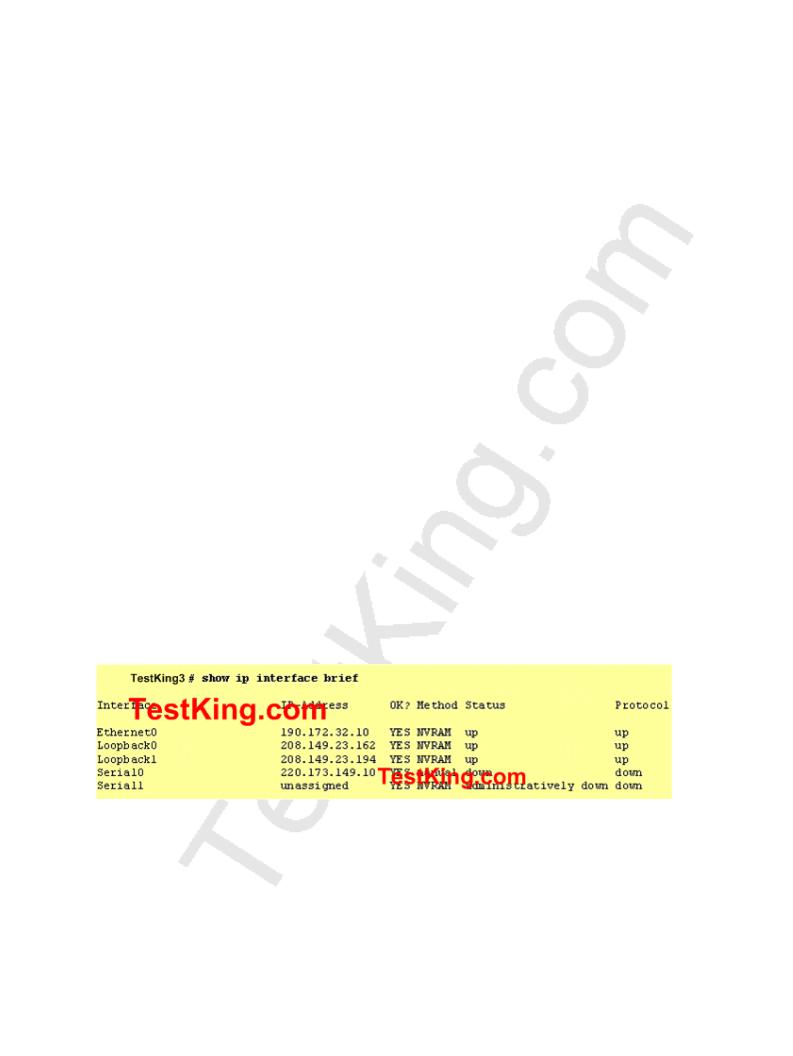
E.It is globally significant.
F.It is shared among all OSPF routers
Answer: B, C
Explanation:
The OSPF process ID is locally significant, and is only used by the local router to discriminate between multiple OSPF processes. In any given OSPF network, the process ID's do not need to match between neighboring routers. This is in contrast to other routing protocols, such as EIGRP.
Additional info: router ospf process-id
no router ospf process-id process-id
Internally used identification parameter for an OSPF routing process. It is locally assigned and can be any positive integer. A unique value is assigned for each OSPF routing process.
Reference: http://www.cisco.com/en/US/products/sw/iosswrel/ps1826/products_command_summary_chapter09186a008
QUESTION NO: 17
The interface information for router TestKing3 is displayed below:
.
Router TestKing3 was just successfully rebooted. Based on the information shown above, correctly identify the current OSPF router ID for Router TestKing3.
Leading the way in IT testing and certification tools, www.testking.com
- 473 -
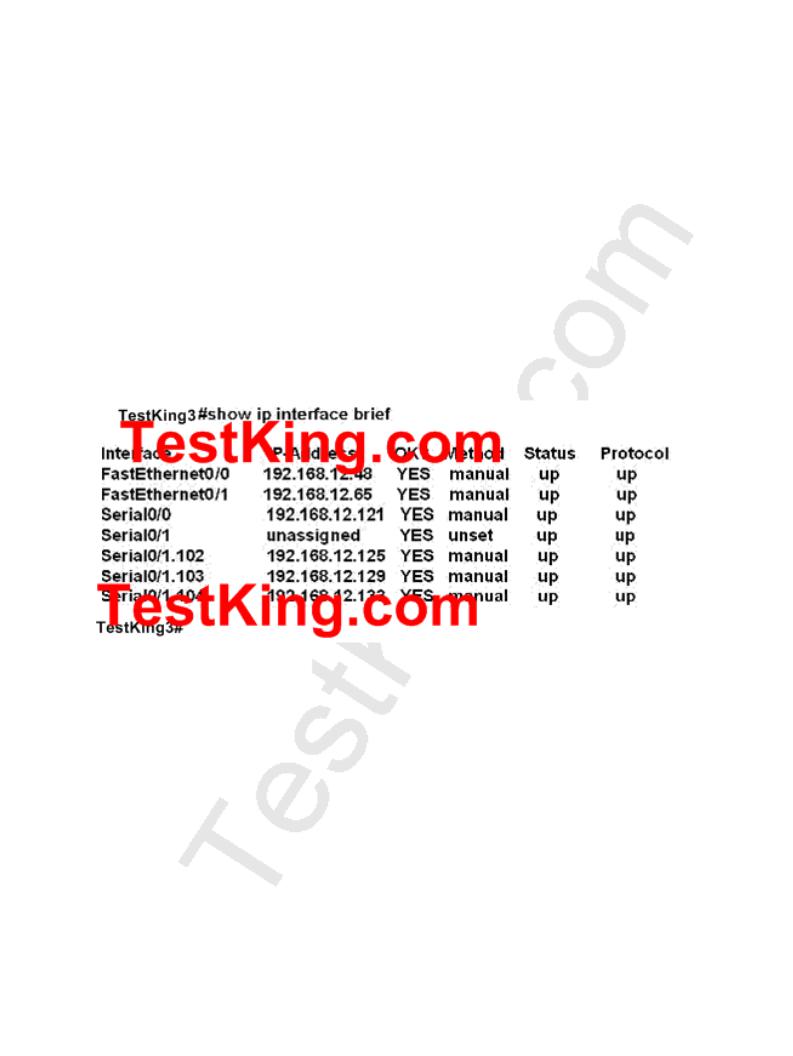
A.220.173.149.10
B.208.149.23.194
C.208.149.23.162
D.190.172.32.10
E.None of the above
Answer: B
QUESTION NO: 18
The interface status for router TestKing3 is as follows:
Prior to the command shown above, you had configured OSPF with the command:
TestKing3(config-router)# network 192.168.12.64 0.0.0.63 area 0
After completing the configuration, you now discover that not all the interfaces are participating in OSPF. Based on the information shown above, which three of the interfaces will participate in OSPF according to this configuration statement? (Choose three)
A.Serial0/1.104
B.Serial0/1.102
C.Serial0/0
Leading the way in IT testing and certification tools, www.testking.com
- 474 -

D.Serial0/1.103
E.FastEthernet0 /1
F.FastEthernet0 /0
Answer: B, C, E
QUESTION NO: 19
Which one of the following privileged EXEC mode IOS show commands will display the state of the OSPF DR/BDR (designated router / backup designated router) election process?
A.TK1# show ip ospf interface
B.TK1# show ip ospf priority
C.TK1# show ospf neighbor detail
D.TK1# show ospf processes
E.TK1# show ospf neighbor state
F.None of the above
Answer: A Explanation:
This command will display the router ID of both the DR and the BDR on the network segment that the particular interface is connected to.
Example:
Router1#show ip ospf interface ethernet 0Ethernet0 is up, line protocol is upInternet Address 10.10.10.1/24, Area 0Process ID 1, Router ID 192.168.45.1, Network Type BROADCAST, Cost: 10 Transmit Delay is 1 sec, State BDR, Priority 1Designated Router (ID) 172.16.10.1,
Interface address 10.10.10.2 Backup Designated router (ID) 192.168.45.1, Interface address 10.10.10.1 Timer intervals configured, Hello 10, Dead 40, Wait 40, Retransmit 5 Hello due in 00:00:06 Index 1/1, flood queue length 0 Next 0x0(0)/0x0(0) Last flood scan length is 2, maximum is 2 Last flood scan time is 0 msec, maximum is 4 msec Neighbor Count is 1, Adjacent neighbor count is 1Adjacent with neighbor 172.16.10.1 (Designated Router) Suppress hello for 0 neighbor(s)
QUESTION NO: 20
On your OSPF network, routers TK1 and TK2 belong to the same Ethernet network. However, they are unable to establish an adjacency over this link. While troubleshooting this problem, you issue the "show ip ospf interface Ethernet 0" command on each router. The output from these commands is displayed below:
Leading the way in IT testing and certification tools, www.testking.com
- 475 -

TK1: Ethernet is up, line protocol is up
Internet address 192.168.1.2/24, Area 0
Process ID 1, Router ID 192.168.31.33, Network Type BROADCAST, Cost: 10
Transmit Delay is 1 sec, State DR, Priority 1
Designated Router (ID) 192.168.31.33, Interface address 192.168.1.2
No backup designated router on this network
Time intervals configured, Hello 5, Dead 20, Wait 20, Retransmit 5
TK2: Ethernet0 is up, line protocol is up
Internet address 192.168.1.1/24, Area 0
Process ID 2, Router ID 192.168.31.11, Network Type BROADCAST, Cost: 10
Transmit Delay is 1 sec, State DR, Priority 1
Designated Router (ID) 192.168.31.11, Interface address 192.168.1.1
No backup designated router on this network
Timer intervals configured, Hello 10, Dead 40, Wait 40, Retransmit 5
What is the underlying cause of the routers failing to become adjacent?
A.The OSPF area is misconfigured.
B.The priority on TK2 should be set lower.
C.The cost on TK2 should be set lower.
D.The hello and dead timers are misconfigured.
E.You need to add a backup designated router to the network.
F.The OSPF process ID numbers do not match.
Answer: D Explanation:
OSPF routers must have the same hello intervals and the same dead intervals to exchange information. By default, the dead interval is four times the value of the hello interval. This means that a router has four chances to send a hello packet before being declared dead.
On broadcast OSPF networks, the default hello interval is 10 seconds and the default dead interval is 40 seconds. On nonbroadcast networks, the default hello interval is 30 seconds and the default dead interval is 120 seconds. These default values result in efficient OSPF operation and seldom need to be modified. As shown in the output, the hello timer on router TK1 was changed to 5 seconds, with the dead timer being set to 20 seconds.
Incorrect Answers:
A.Both routers are configured to be in area 0.
B.In this example the adjacency should come up regardless of which one was the
DR/BRD. Therefore, setting the priority on one router will not solve this problem.
Leading the way in IT testing and certification tools, www.testking.com
- 476 -

C. This will not solve the adjacency issue.
E.Only the DR is absolutely required on the Ethernet subnet, not the BDR.
F.Unlike other protocols, the routing process ID's do not necessarily need to match in OSPF for routing to work.
QUESTION NO: 21
Router TK1 is being installed. You wish to add this router to your existing OSPF network. In doing so, you configure the following:
TK1(config)# router ospf 1
TK1(config-router)# network 10.10.10.0 255.255.255.0 area 0
After making this change, you notice that the networks attached to TK1 are not being learned by the other OSPF routers. What could be the cause of this?
A.The AS is not correctly configured
B.The network subnet mask is incorrectly configured
C.The network wildcard mask is configured incorrectly
D.The network number is not correctly configured
E.The process id is configured incorrectly
F.None of the above
Answer: C Explanation:
The network command specifies the IP address (10.10.10.0) followed by the wildcard mask (not the subnet mask) and the area that is to be associated with the OSPF address range (in this case, area 0). The wildcard mask indicates in binary how much of the IP address much be matched with 0s indicating that the bits must match and 1 indicating that they may vary. Thus 0.0.0.255 or 00000000.00000000.00000000.11111111 indicates that any bit in the last octet can vary while all bits in the first 3 octets must match the network address (in other words, 10.10.10.xx)
Incorrect Answers:
A.Here the process ID is 99, which is valid.
B.Area 0 is the backbone area, so configuring the network to be in area 0 should be acceptable.
D.This is not the problem, assuming that all 10.X.X.X networks are to be configured for OSPF.
E.The AS number, as called the process ID in OSPF is 99.
F.OSPF uses wildcard masks, not the usual subnet masks
Leading the way in IT testing and certification tools, www.testking.com
- 477 -
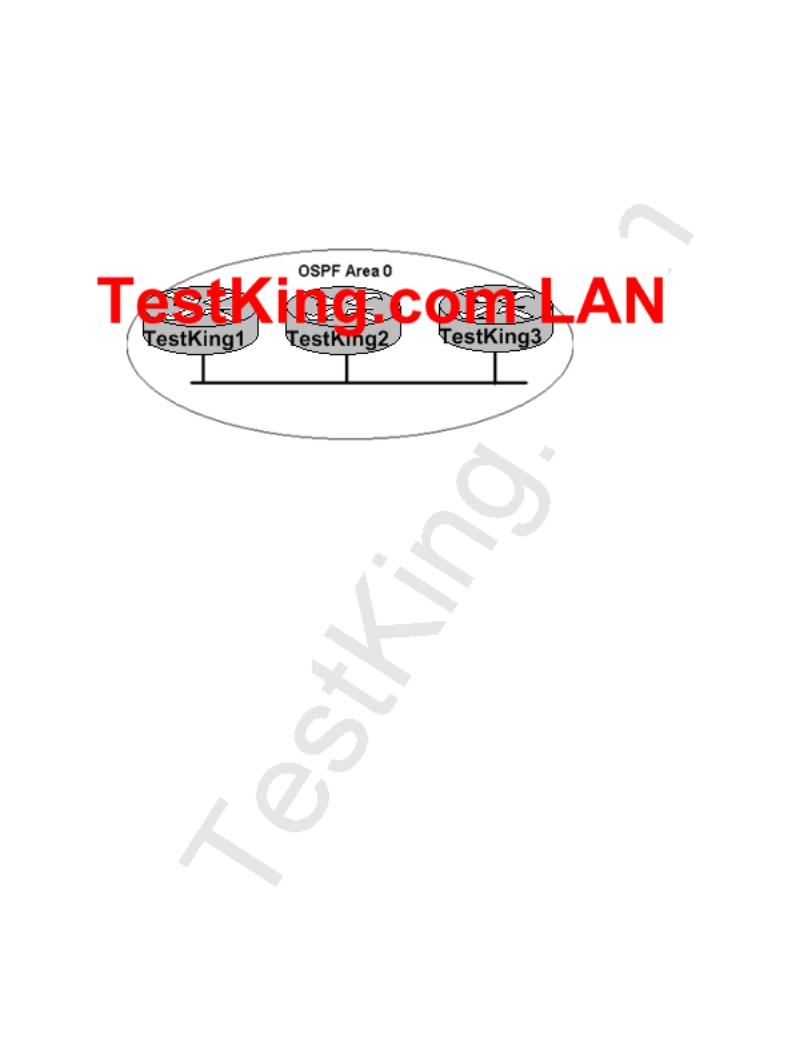
QUESTION NO: 22
The TestKing OSPF Backbone network is displayed below:
TESTKING1 is unable to establish an OSPF neighbor relationship with TESTKING3. What are possible reasons for this problem? (Choose Two).
A.All of the routers need to be configured for backbone Area1.
B.TESTKING1 and TESTKING2 are the DR and BDR, so OSPF will not establish neighbor adjacency with TESTKING3
C.A static route has been configured from TESTKING1 to TESTKING3 and prevents the neighbor adjacency from being established.
D.The hello and dead interval timers are not set to the same values on TESTKING1 and TESTKING3.
E.EIGRP is also configured on these routers with a lower administrative distance.
F.TESTKING1 and TESTKING3 are configured in different areas.
Answer: D, F
Explanation:
In order for two OSPF routers to establish a neighbor adjacency, they must agree on a number of things, including the hello intervals, dead intervals, and the area ID's. Although a router can be configured for multiple OSPF areas, a neighbor relationship will only be built on interfaces that share the same area.
Leading the way in IT testing and certification tools, www.testking.com
- 478 -
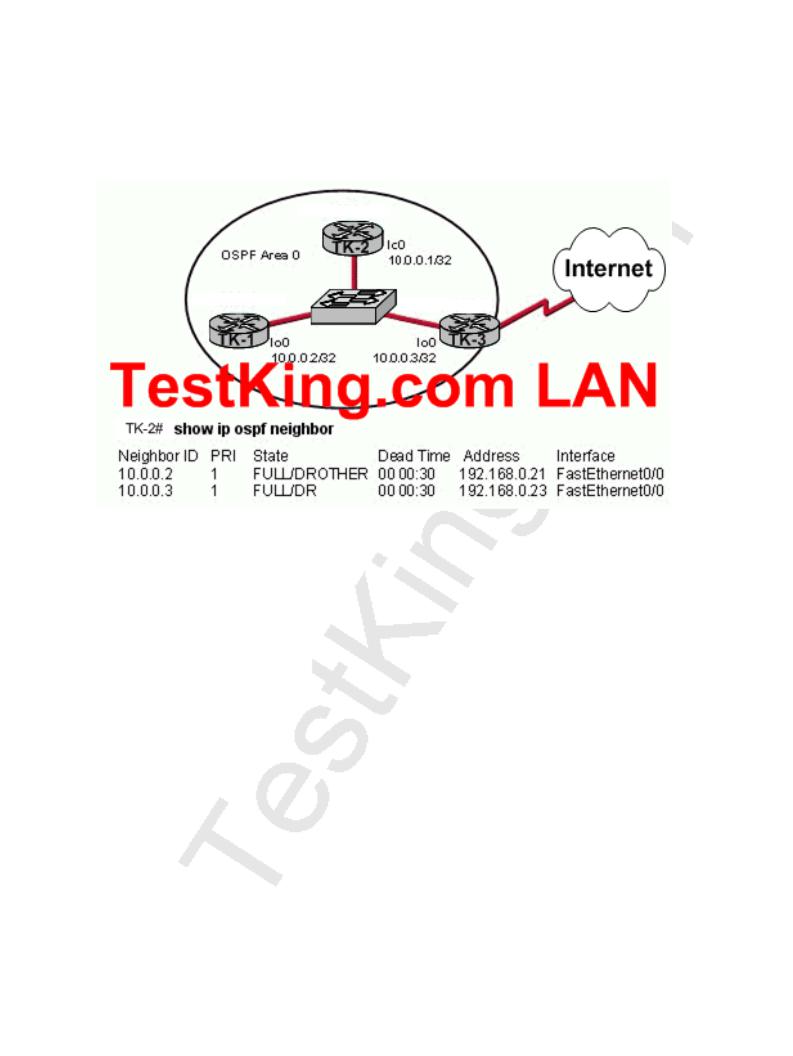
QUESTION NO: 23
The TestKing OSPF network is shown below:
Based on the output from the show ip ospf neighbor command on TK-2, what must a network administrator do to ensure that TK-2 will always be the DR and TK-3 will never be the DR or BDR for OSPF area 0? (Choose three.)
A.Set the TK-3 OSPF priority to 0 on the serial interface.
B.Change the TK-2 FastEthernet IP address to 192.168.0.27.
C.Set the TK-2 OSPF priority to 255 on the FastEthernet interface.
D.Change the TK-3 FastEthernet IP address to 192.168.0.27.
E.Set the TK-3 OSPF priority to 0 on the FastEthernet interface.
F.Set the TK-1 OSPF priority to 0 on the FastEthernet interface.
Answer: C, E, F Explanation:
In OSPF, the DR is the router responsible for making adjacencies with all neighbors on a multiaccess network, such as Ethernet or FDDI. The DR represents the multiaccess network, in that it ensures that every router on the link has the same topology database.
The BDR is the backup to the designated router (DR), in case the DR fails. The BDR performs none of the DR functions while the DR is operating correctly.
Router(config-if)#ip ospf priority number
Leading the way in IT testing and certification tools, www.testking.com
- 479 -
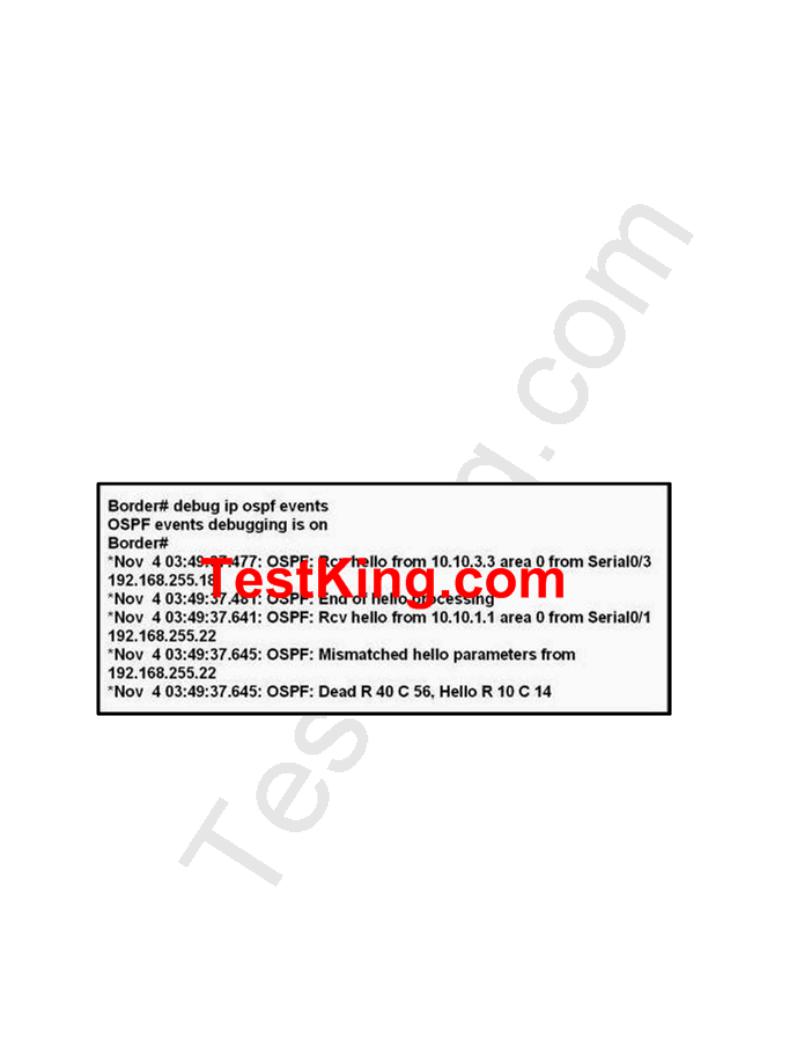
The number in the priority command can be set between 0-255, where the higher the number, the greater the likelihood that this router will be selected as the DR.
To determine manually which router will be the DR, it is necessary to set the priority of the router. A router interface can have a priority of 0 to 255. The value of 0 means that the router cannot be a DR or BDR; otherwise, the higher the priority, the more favorable the chances are of winning the election. If there is more than one router on the segment with the same priority level, the election process picks the router with the highest router ID. The default priority on a Cisco router is 1.
If Priority value is same then goes to the highest IP address assigned in loopback interface then any interface.
QUESTION NO: 24
Referring to the Testking Border router shown below, what can be concluded from the output of this debug command?
Exhibit:
A.The output represents normal OSPF operation.
B.The OSPF router connected to interface Serial0/1 has NOT formed a neighbor relationship with the Border router.
C.The interfaces of two OSPF routers connected to the Border router are in the same subnet.
D.A router is connected to interface Serial0/3 of the Border router. The OSPF router ID of the connected router is the IP address of the connected interface.
E.None of the above
Leading the way in IT testing and certification tools, www.testking.com
- 480 -
